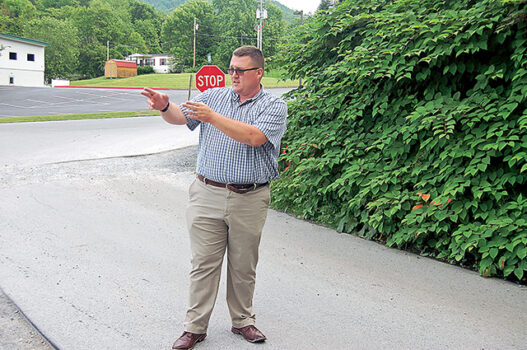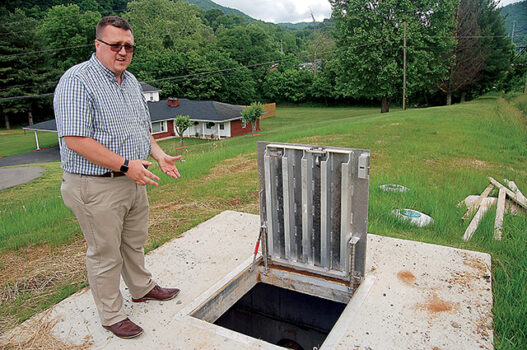‘Pipes to People’: City water resource project safeguards key pipeline
Published 5:18 pm Monday, May 20, 2024
|
Getting your Trinity Audio player ready...
|
By Buzz Trexler
Star Correspondent
It’s late in the day and a cloud-covered sky is promising more May rain as Jonathan Pleasant walks around what has been a monthslong construction zone at the Doe River Water Project.
Small sections of 12-inch pipe remain in the paved area along a section of Doe River, across from Valley Forge Freewill Baptist Church on Riverview Drive. They are all that is left of about 2,600 linear feet of such pipe, while construction equipment that seemed ever present this past winter and spring has apparently moved on to other projects.
For Elizabethton’s Water Resources general manager, the absence of equipment and the diminished stack of pipe is a good sign as he walks beneath the U.S. 19E bridge spanning the Doe. Pleasant expects the project, which began in earnest in 2019, will meet his June 30 deadline weeks in advance.
Pleasant says most of the city’s water comes from three sources: Hampton Spring, which is the oldest and largest source, for which the town of Hampton draws its name; Big Springs, which is over in Gap Creek and feeds the Milligan area in the West End of town; and Valley Forge Spring, which flows out of a mountain and into a reservoir on the Doe River across from the city’s water treatment facility on Journey’s End Road.
Hampton and Valley Forge springs account for 75 percent of the city’s water usage and flows through the two lines that run beneath the bed of Doe River near the U.S. 19E bridge at Riverview Drive.
Standing below the bridge, Pleasant speaks with a sense of marvel as he describes some of the early 20th-century engineering of the water resource system that transported water to city residents from Hampton Spring. That original 1908 line, which still runs through the riverbed, is a cast-iron pipe that runs from Hampton Spring. “And when they put that in, they didn’t even have pumps back then,” he said. “It was a gravity system that went to a tank on Paty Hill, kind of where our current Paty Hill tank is.
“When they put that system in originally, it was set so that the Paty Hill tank was the same elevation as Hampton Springs,” Pleasant said. “So, when water got used down, just natural gravity would fill it back up coming from the spring. They had it engineered that well.”
The other line in the riverbed transports water from the Valley Forge Spring by way of a 16-inch ductile iron pipe that was installed sometime in the 1960s, Pleasant said. However, flooding and erosion of the original concrete shielding have left both pipelines more exposed in the riverbed.
The Search for a Solution
According to reports, the city applied for an Appalachian Regional Commission (ARC) grant in 2017, but it was denied. The city reapplied to ARC in 2018 and the application included an engineering report from McGill Associates that explained a breakage in the current lines would lead to months of interrupted water service, with possible catastrophic effects: loss of drinking water and sanitary services; loss of fire protection; the closure of businesses and industries; and the inability of hospitals and schools to function.
The McGill engineers outlined three options: use the existing US 19E Bridge to support new lines as they cross the river; bore through the bedrock beneath the Doe Driver; or construct a new bridge to carry pipes over the river.
“The first one they kind of ruled out was the boring through the rock,” Pleasant says. “They wouldn’t let us do that because that’s when we found out it was considered a navigable river. Army Corps of Engineers and TVA both got involved on that one.”
Pleasant said the Tennessee Department of Transportation originally turned down the idea of running new pipelines on the U.S. 19E bridge, thus leaving the city with the remaining option of constructing a pipe bridge. The city was already into the pipe bridge design work, he said, when TDOT did a follow-up review and approved using the existing bridge. “Of course, that was our preferred option anyway,” Pleasant said.
The project was split between two contractors: Merkel Brothers Construction Inc., of Greeneville, was awarded a $1,589.250 contract, while Haren Construction Company Inc., of Etowah, was awarded a $1,206,000 contract.
Funding for the $3,845,250 project comes from an ARC grant, the State Revolving Loan Fund, retained earnings, and American Rescue Plan Act funds. Due to the expiration of the ARC grant, the project has to be completed by June 30.
Pleasant expects it to be completed this week.
In Praise of Mountain Water
Over at the Valley Forge Spring and water resource facility, Pleasant explains that more than a million gallons of water a day flows through that system.
“What’s neat about this thing is it has the best technology, because it’s actually like a membrane filtration system with really small particles that pushes the water through,” he says with pride.
“I think that’s something people don’t realize: we are very blessed with the water we’ve got — very high quality,” Pleasant says, calling it “some of the cleanest in the United States.” Since the city does not have to take “surface water,” he says the spring-sourced water does not require the high level of treatment some municipalities face due to heavy industry and other factors.
As the sound of water cascading from the overfilled reservoir and the Doe River fills the background, Pleasant says, “I mean, obviously, it’s coming straight from the source: to the pipes to the people.
“There’s no in between.”












